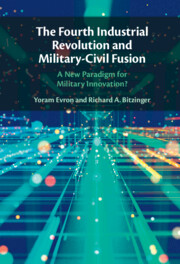Book contents
- The Fourth Industrial Revolution and Military–Civil Fusion
- The Fourth Industrial Revolution and Military–Civil Fusion
- Copyright page
- Dedication
- Contents
- Figures
- Tables
- Acknowledgments
- Abbreviations
- 1 Introduction
- 2 Military–Civil Fusion
- 3 MCF in the United States of America
- 4 MCF in China
- 5 MCF in India
- 6 MCF in Israel
- 7 Conclusions
- Bibliography
- Index
3 - MCF in the United States of America
Published online by Cambridge University Press: 01 June 2023
- The Fourth Industrial Revolution and Military–Civil Fusion
- The Fourth Industrial Revolution and Military–Civil Fusion
- Copyright page
- Dedication
- Contents
- Figures
- Tables
- Acknowledgments
- Abbreviations
- 1 Introduction
- 2 Military–Civil Fusion
- 3 MCF in the United States of America
- 4 MCF in China
- 5 MCF in India
- 6 MCF in Israel
- 7 Conclusions
- Bibliography
- Index
Summary
The defense industry in the United States that emerged during World War II is embedded in the nation’s civilian sector but arms manufacturing has remained segregated from the civilian economy. Earlier rounds of civil–military integration, particularly in aerospace and computing, resulted in military and civilian technology silos, despite efforts in the post-Cold War era to create a dual-use technology base. In the twenty-first century, however, the US military’s emerging technological requirements have driven a new effort to exploit fourth industrial revolution (4IR) technologies through military–civil fusion (MCF). In particular, the US military seeks to exploit such 4IR technologies as AI, quantum computing, microelectronics, and autonomous systems. The US Department of Defense has undertaken several initiatives to access advanced commercial innovations, particularly in the IT sector. AI is particularly driving MCF as this is seen as a critical force multiplier in future warfare. It is too soon to ascertain how successful current US efforts at MCF will be as many of the current programs sponsoring MCF are still at the initial stages of exploration, experimentation, and evaluation.
Keywords
- Type
- Chapter
- Information
- The Fourth Industrial Revolution and Military-Civil FusionA New Paradigm for Military Innovation?, pp. 49 - 87Publisher: Cambridge University PressPrint publication year: 2023



